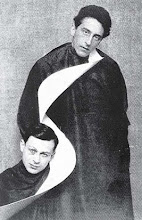None of the magazines and newspapers I read these days ever seem to
mention the pianists, cooks and authors Arthur Gold (1917-1990) and Robert Fizdale (1920-1995).
This wasn't always the case.
As musicians, Gold and Fizdale performed from the 1940s through the 1970s as a two-piano team
on the international classical concert circuit. "The Boys," as they were known to their many celebrated musical, literary and culinary friends, championed the work of modern composers and commissioned and premiered important 20th century piano works, including compositions by
John Cage, Virgil Thompson, Paul Bowles, Ned Rorem, and the group of French composers
pictured below, known as Les Six.
Les Six plus one (Jean Cocteau at
piano) in the 1920s: Darius Milhaud, outline of Georges Auric, Arthur Honegger,
Germaine Tailleferre, Francis Poulenc, and Louis Durey (file photo)
As writers (a profession they adopted after Gold began suffering problems with his hands, which affected his playing), they wrote biographies, including "Misia: the Life of Misia Sert" (William Morrow 1981), "The Divine Sarah: a Biography of Sarah Bernhardt" (Knopf 1991), as well as journalism for Vogue and the excellent "Gold and Fizdale Cookbook" (Random House, 1984), a superb collection of recipes and travel/music/musician/dance and dancer lore.
The following two recipes only hint at the book’s qualities
(the recipes are really good and well-written; it is also a handsome, well laid-out volume), but
give no real idea of G&F's range.
No matter – braised endives are, I think, my favorite dish [1] and
George Balanchine’s mother’s Gogl-Mogl recalls events from my own
childhood. My mother’s father was
Russian and she occasionally served something similar to my brother and
me. I hadn’t thought about that until
just a moment ago. Because my grandfather was basically non-communicative for most of the time I knew him (apparently, this wasn't always the case), the egg and sugar froth sparkles this memory.
So: Vive Gold and Fizdale! Vive Gogl-Mogl! And Vive La Belgique -- home of the (Belgian) endive (aka witloof) and my friend Marvin Siau of Starvin Marvin and the Paranoid Androids!
Braised Endives
(Endive Braisées)
12 medium-size endives
1 stick (1/4 pound) butter
Salt and freshly ground pepper to taste
Juice of half a lemon
¼ cup chicken broth or water
Preheat the oven to 350 degrees.
Trim off the root
ends with a small knife, and discard any wilted outer leaves. Never let endive sit in water, as that will
exaggerate the bitterness. If they are
fairly clean to start with, just wipe them with a damp cloth.
Generously butter
the bottom of a 3-quart flameproof enameled casserole and arrange the endives
close together in two layers. Season
each layer with salt, pepper and lemon juice.
Dot with the remaining butter.
Add the broth or water. Simmer,
covered, for 10 minutes, then boil, uncovered, for another 10 minutes, or until
the liquid has reduced to a few tablespoons.
Cut a round of paper to fit the top of the casserole and butter it well. Lay the paper, buttered side down, on the
endive, cover the casserole and bake for about 1 hour.
OPTIONAL: When
cooked, arrange the braised endives in a shallow baking dish, dot with more
butter, and brown under the broiler for a minute or two.
GOGL-MOGL
“Like Proust’s
Madeleine, gogl-mogl, a frothy mixture of egg yolks whipped with sugar, evoked
Balanchine’s childhood for him. ‘At
bedtime, my brother, sister and I sat around Mama in a semi-circle. She had a glass of gogl-mogl and a
spoon. While she fed one, the other two
watched to see who got the biggest spoonful.
We were like little birds in a nest fed by the mama bird.”
6 egg yolks
6 tablespoons sugar
½ tablespoon vanilla
Put all the ingredients in the top of a double-boiler over
simmering water. Beating continuously,
heat until light, fluffy, and somewhat thick.
Pour into a bowl or into wineglasses and chill.
NOTE:
[1] Because, as I mentioned, braised endives are
about my favorite thing to eat, I thought I would include the preparation below, which is the one I use most
often. I think it's one of Pierre Franey's 60 Minute Gourmet recipes and is simpler and much quicker to make than the Gold and Fizdale version. Endive season is upon us. We recently found a good and inexpensive
local source for this prized, once much rarer item.
Braised Shredded Endives
1 1/4 lbs. fresh Belgian endive
2 tbsp. butter
Juice of half a lemon or lime
Salt and freshly ground pepper to
taste
1/4 tsp. sugar
1. Trim off the ends of each endive. Place the endives on a flat surface and cut
on the diagonal into very thin strips.
There should be about 6 cups of shredded endives.
2. Heat the butter in a heavy skillet and add
the endives. Add the lemon juice, salt,
pepper and sugar.
3. Cook, stirring
often, about 3 minutes or until wilted.
Cover and cook about 8 minutes.
Uncover and continue cooking, stirring often, about 3 or 4 minutes until
lightly browned.
































